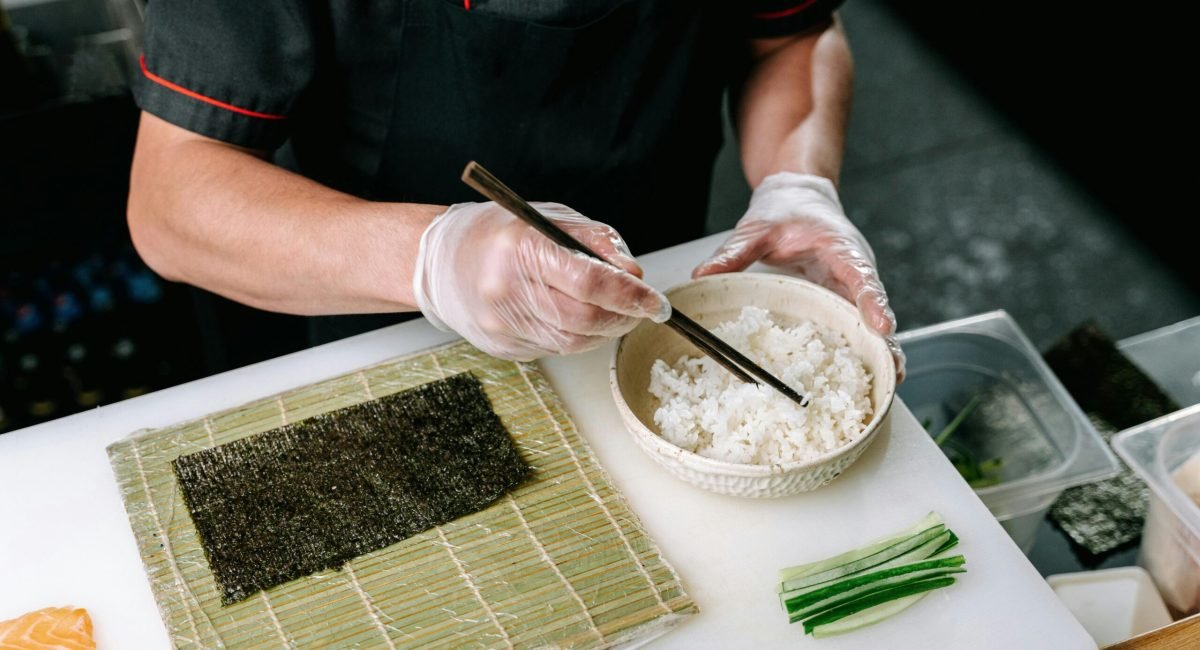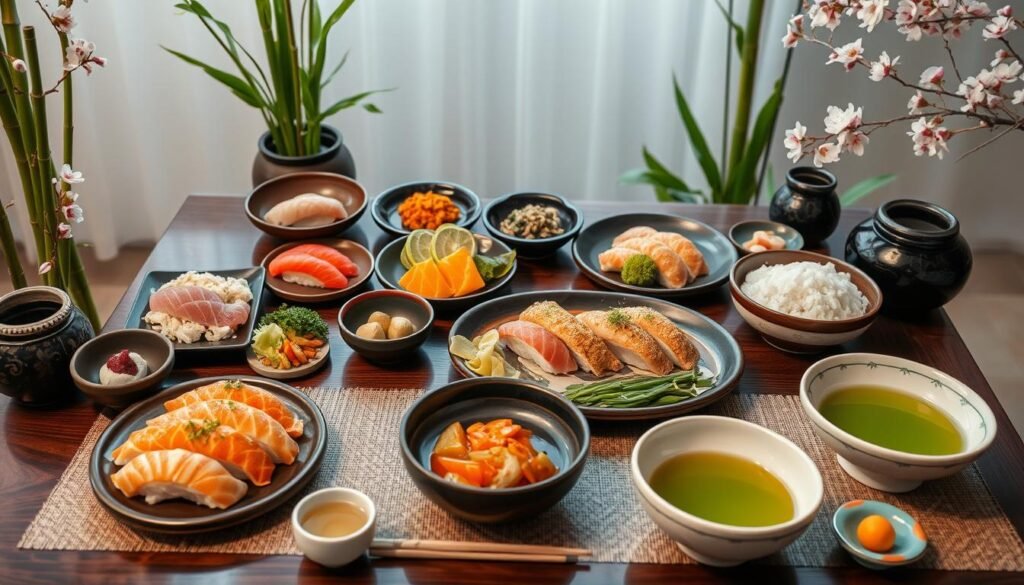
Secrets of Japan’s Healthy Lifestyle: Japan has a very low obesity rate, with only 3.6% of adults being obese1. This is due to their unique approach to health. They have efficient public transport, healthy diets, and cultural practices. These all play a big role in Japan’s low obesity rate.
The average life expectancy in Japan is over 84 years, one of the highest in the world. This is often linked to their diet1. Many people are interested in Japan’s approach to health and wellness.
The traditional Japanese diet is known for being low in obesity. It focuses on whole, nutrient-dense foods. This diet is a big part of Japan’s healthy lifestyle.
Key Takeaways
- Japan has a low obesity rate of approximately 3.6%1, contributing to the country’s high life expectancy.
- The traditional Japanese diet is rich in nutrients, including fiber, calcium, and vitamins A, C, and E1, which are essential for healthy living in japan.
- Japanese cultural practices, such as eating until 80% full, help reduce overall calorie intake and prevent overeating1, which is a key aspect of japan’s low obesity.
- The consumption of green tea, a staple in the Japanese diet, is linked with protective effects against various diseases1, making it a critical part of japanese well-being.
- The Japanese diet emphasizes fish and seafood, with fish consumption being a major dietary component1, providing essential nutrients for healthy living in japan.
- Regular physical activity, such as walking, is an integral part of Japanese daily life2, contributing to the overall secrets of japan’s healthy lifestyle.
- Social connections and community gatherings are prevalent in Japan, helping to maintain meaningful relationships3, which is essential for japanese well-being and healthy living in japan.
Understanding Japan's Remarkable Health Statistics

Japan has a very low obesity rate, with only 4% of adults being obese4. This is a remarkable fact that has been studied a lot. It’s because of a healthy diet, regular exercise, and a strong focus on wellness.
The traditional Japanese diet is full of fish, seafood, soybeans, and green tea. These foods have many health benefits5.
Walking and cycling are big parts of Japanese culture. Many people make these activities a part of their daily life4. This helps keep the obesity rate low.
Some important factors for Japanese longevity include:
- A healthy diet, with lots of fruits, vegetables, and whole grains
- Regular physical activity, like walking and cycling
- A strong focus on wellness, including managing stress and staying connected with others
Traditional Japanese Dietary Principles

In Japan, wellness trends stress the value of fermented foods and probiotics for a healthy gut. Japanese meals often include steamed rice, miso soup, and various side dishes like fermented veggies and soy products8. The Japanese eat about 25% fewer calories daily than Americans, which may help them live longer9.
Some key parts of the traditional Japanese diet are:
Following these diet principles can bring many health benefits. It can lower the risk of chronic diseases and increase longevity9. By adopting these Japanese diet tips, you can enhance your health and wellbeing.
Daily Movement and Physical Activity in Japanese Culture

Here are some ways Japanese people stay active:
- Walking or cycling to work or school
- Engaging in outdoor activities, such as gardening or sports
- Participating in community-based exercise programs
- Practicing martial arts, such as karate or judo
| Activity | Frequency | Benefits |
|---|---|---|
| Walking | Daily | Improves cardiovascular health, reduces risk of chronic diseases |
| Cycling | Several times a week | Improves cardiovascular health, reduces risk of chronic diseases |
| Martial arts | Several times a week | Improves physical fitness, reduces stress and anxiety |
Mindful Eating Practices and Cultural Attitudes
In Japan, healthy eating is a big deal. They focus on eating the right amount and choosing foods that are good for you12. Mindful eating is a big part of their culture. They enjoy their food slowly, pay attention to how it looks, and eat with others.
Slow eating is a key part of Japanese culture. They take their time eating, enjoying every bite. This helps them eat better and feel better. Cooking food in ways that keep it healthy, like steaming, also makes it taste better.
How food looks is very important in Japan. They use small plates to help control how much they eat. We can do this at home by using smaller plates. Adding foods like miso to our meals can also make them healthier.
Here are some tips for eating mindfully:
- Eat slowly and savor each bite
- Pay attention to the flavors, textures, and aromas of the food
- Use small plates and bowls to control portion sizes
- Incorporate fermented foods and balanced meals into our diet
- Practice cooking techniques that retain the nutritional value of foods
| Food | Portion Size | Calories |
|---|---|---|
| Rice | 150g | 200 |
| Miso soup | 100g | 50 |
| Vegetables | 350g | 100 |
Secrets of Japan's Healthy Lifestyle: A Guide to Low Obesity and Well-Being
Japan’s healthy lifestyle is more than just diet and exercise. It also includes mental and emotional well-being. The country’s low obesity rate, around 3.6% for adults15, comes from a balanced diet and regular activity. To follow japan lifestyle tips, try a low obesity lifestyle guide that focuses on whole foods and mindful eating.
Japanese health secrets include natural medicine and traditional remedies. Their diet is full of nutrients, helping with digestion, weight loss, and longevity15. Japanese meals often include fermented foods, probiotics, and lots of vegetables. For instance, they eat nearly five times more cabbage than Westerners16.
Here are some diet and fitness in japan tips for a balanced lifestyle:
- Eat a variety of whole, unprocessed foods
- Practice mindful eating and portion control
- Incorporate physical activity into your daily routine
- Try stress-reducing techniques, such as meditation or forest bathing (Shinrin-Yoku)
By following these japanese health secrets, you can boost your health and well-being. This can also lower your risk of chronic diseases15.
Conclusion: Adapting Japanese Health Wisdom for Western Living
FAQ
What is the secret behind Japan’s remarkably low obesity rate?
How does the traditional Japanese diet contribute to their low obesity rates?
What role does daily movement and physical activity play in Japanese culture?
How do mindful eating practices contribute to Japan’s healthy lifestyle?
What other secrets of Japan’s healthy lifestyle can be incorporated into Western living?
Source Links
- The Japanese Diet: Benefits, Food List, and Meal Plan
- 8+ Simple Japanese Lifestyle Habits, You Should Try to Stay In Top Shape
- The Secrets to Japan’s Longevity: Lessons for a Healthier, Longer Life
- What the U.S. could learn from Japan about making healthy living easier
- Why has Japan become the world’s most long-lived country: insights from a food and nutrition perspective – European Journal of Clinical Nutrition
- Understanding the Japanese Diet and Magowayashii Philosophy
- Japanese Eating Habits and Dietary Guide
- Using the Traditional Japanese Diet for Weight Loss: The Full Guide | LuckyFit
- Diets of the World: The Japanese Diet
- The Secret to Lifelong Fitness: Walking the Japanese Way
- Japan’s Cultural Shift, Strategies for Low Obesity Rates
- Nutrition and Food Education in Japan
- Why is the Japanese diet so healthy?
- The Role of the Japanese Traditional Diet in Healthy and Sustainable Dietary Patterns around the World
- Dr Sumit Kapadia on LinkedIn: #japan #update #health
- Japanese Eating Habits and Dietary Guide
- Lifestyle Medicine and Japan’s Longevity Miracle
- 7 Reasons Why Japanese Children Have the Longest, Healthiest Lives
- The “1975 Diet” and the Secret of Japanese Longevity